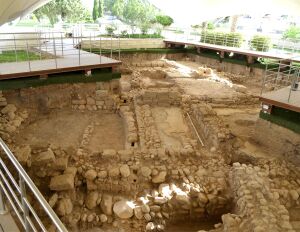 Leonid A. Belyaev*, Alexey N. Voroshilov**, Olga M. Voroshilova***, Anastasiya A. Maksimova****
Leonid A. Belyaev*, Alexey N. Voroshilov**, Olga M. Voroshilova***, Anastasiya A. Maksimova****
Institute of Archaeology RAS, Moscow, Russia
*E-mail: labeliaev@bk.ru
**E-mail: voroshilov.aleksej@yandex.ru
***E-mail: helga-mir@yandex.ru
****E-mail: anastasiya.maksimova@gmail.com
Keywords: archaeology of the Syrian-Palestinian region, Holy Land, Jericho, Byzantine archaeology, history of archaeology, historical archaeology, archival research.
The paper presents latest data on excavations at the site of the Russian Museum and Park Complex in Jericho. The research is being conducted on a site that contains two types of structures. The first is a large house with stone walls and mosaic floors, revealed in the 1880s by the N.P. Kondakov expedition. The contemporary research identified the structure transformations at the end of the Byzantine period (the 6th–first half of the 8th century). Nearby, a large structure of mud bricks in the lower layer and, presumably, part of an early stone colonnade of this monumental complex were found. The second is the production area where a number of successively used pottery kilns were unearthed that had operated until the end of the Umayyad dynasty. That area was developed later, in the Mamluk period. The everyday nature of the area development in the specified time is indicated by the presence of tandoors. The authors focus on the development of the archaeology activities of Russian pilgrimage in the 18th–19th centuries and on the work of the Jericho Expedition for the preparation and publication of archival materials related to the work of Russian researchers in Palestine during the Ottoman period.
DOI: 10.31857/S086960630014915-5







